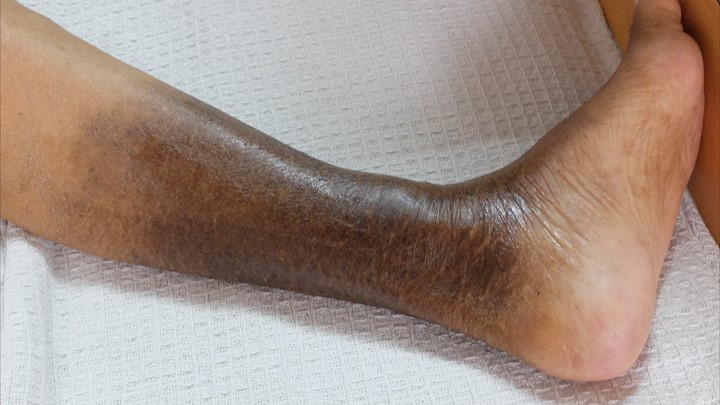Leg ulcers can be a painful and debilitating condition that can significantly impact a person’s quality of life. They can develop due to a variety of factors, including poor circulation, underlying medical conditions, and injuries.
If left untreated, leg ulcers can lead to serious complications such as infections and tissue damage. With proper treatment and prevention strategies, it is possible to manage and prevent the development of leg ulcers.
In this blog post, we will discuss the common leg ulcer causes, prevention and treatment options, and prevention strategies that can help you maintain healthy skin and circulation in your legs.
What is Leg Ulcer (Ache Ere)?
Leg ulcers are open sores or wounds that develop on the legs and can be caused by a variety of factors.
Common Leg Ulcer Causes
1. Venous insufficiency
This is the most common cause of leg ulcers, accounting for about 80% of cases. It occurs when the veins in the legs are unable to pump blood back to the heart efficiently, causing blood to pool in the veins and leading to swelling, inflammation, and ulceration.
2. Arterial insufficiency
This occurs when there is a blockage or narrowing of the arteries in the legs, leading to a reduced blood supply to the tissues. This can cause tissue damage and lead to the development of ulcers.
3. Diabetes
Diabetes can cause damage to the nerves and blood vessels in the legs, which can lead to poor circulation and reduced ability to heal wounds. This increases the risk of developing leg ulcers.
4. Infection
Infections of the skin or underlying tissues can cause ulcers to form on the legs. This can occur due to a variety of reasons, including poor hygiene, injury, or an underlying medical condition.
5. Trauma
Injuries to the skin or underlying tissues can cause ulcers to form. This can occur due to accidents, surgery, or other medical procedures.
6. Autoimmune diseases
Certain autoimmune diseases, such as lupus and scleroderma, can cause damage to the blood vessels and skin, leading to the development of leg ulcers.
7. Cancer
Some types of cancer, such as melanoma and squamous cell carcinoma, can cause ulcers to form on the legs.
8. Medications
Certain medications, such as steroids and immunosuppressants, can increase the risk of developing leg ulcers.
Note that some people may have more than one underlying condition that may contribute to the development of leg ulcers.
Leg Ulcer Treatment
The treatment of leg ulcers depends on the underlying cause of the ulcer and the severity of the condition. In general, treatment aims to promote healing, reduce inflammation, prevent infection, and improve blood circulation. Here are some common treatments for leg ulcers:
1. Compression therapy
Compression therapy involves using specially designed stockings or bandages to compress the affected area of the leg. This helps to reduce swelling, improve blood circulation, and promote healing. Compression therapy is particularly effective in cases of venous insufficiency.
2. Wound care
The ulcerated area must be kept clean and free of debris to prevent infection. Dressings and topical medications may be applied to the wound to promote healing and prevent infection. Your healthcare provider will determine the best type of dressing or medication to use based on the severity of the ulcer.
3. Medications
In some cases, medications may be prescribed to treat the underlying cause of the ulcer. For example, antibiotics may be used to treat an infection, while medications to improve blood flow may be prescribed for arterial insufficiency.
4. Surgery
In some cases, surgery may be necessary to treat the underlying cause of the ulcer. For example, surgery may be needed to remove blockages in the arteries or veins.
5. Lifestyle changes
Certain lifestyle changes can help to prevent the development of leg ulcers or reduce the risk of recurrence. These may include losing weight, quitting smoking, exercising regularly, and eating a healthy diet.
The treatment of leg ulcers can be a lengthy process, and it may take several weeks or months to see improvement. We recommend working closely with your healthcare provider and following their recommended treatment plan to achieve the best possible outcome.
Leg Ulcer Prevention
Preventing leg ulcers involves addressing the underlying conditions that increase the risk of developing the ulcers. Here are some steps you can take to help prevent leg ulcers:
1. Maintain a healthy lifestyle
Eating a healthy diet, exercising regularly, and avoiding smoking can help improve blood flow and reduce the risk of developing ulcers.
2. Practice good hygiene
Keeping the skin clean and dry can help prevent infections that may lead to the development of ulcers.
3. Manage underlying conditions
Treating underlying conditions such as diabetes, high blood pressure, and high cholesterol can help reduce the risk of developing leg ulcers.
4. Wear compression stockings
If you have a history of venous insufficiency, wearing compression stockings can help improve blood flow and reduce the risk of developing ulcers.
5. Take breaks during long periods of sitting or standing
If you spend long periods of time sitting or standing, take breaks to stretch your legs and move around. This can help improve blood flow and reduce the risk of developing ulcers.
6. Protect your skin
Protect your skin from cuts, scrapes, and other injuries by wearing protective clothing and shoes. This is particularly important if you have a history of developing ulcers.
7. Seek prompt medical attention
If you notice any signs of infection, such as redness, swelling, or warmth around a wound, seek medical attention promptly. Early treatment can help prevent the development of ulcers.
In Conclusion
Leg ulcers can be a serious and debilitating condition that requires prompt medical attention. Treatment options may vary depending on the underlying cause of the ulcer but may include compression therapy, wound care, medications, surgery, and lifestyle changes.
Preventative strategies, such as maintaining a healthy lifestyle, practicing good hygiene, and protecting the skin, can help reduce the risk of developing leg ulcers and promote healthy skin and circulation in the legs.



